HONDA PRELUDE 2000 Owner's Manual (in English)
Manufacturer: HONDA, Model Year: 2000, Model line: PRELUDE, Model: HONDA PRELUDE 2000Pages: 293, PDF Size: 3.43 MB
Page 141 of 293

138
Page 142 of 293

Drivin
g
This section gives you tips on starting the engine under various
conditions, and how to operate the 5-speed manual and automatic
transmissions. It also includes important information on parking
your car, the braking system, and
facts you need if you are planning to
tow a trailer.
Preparing to Drive......................... 140
Starting the Engine........................ 141
Starting in Cold Weatherat High Altitude..................... 141
5-speed Manual Transmission..... 14
2
Recommended Shift Points...... 143
Engine
Speed Limiter ............... 143
Automatic Transmission............... 144 Shift Lever Position Indicator.. 144
Shift Lever Positions................. 145
Engine Speed Limiter............... 150Shift Lock Release..................... 151
Parking............................................ 152
The Braking System...................... 153 Brake Wear Indicators.............. 153
Brake System Design................ 154
Anti-lock Brakes........................ 154 Important Safety
Reminders.......................... 155
ABS Indicator......................... 156
Active Torque Transfer System .. 157 Driving in Bad Weather................ 158
Towing a Trailer............................ 160
Driving
Page 143 of 293
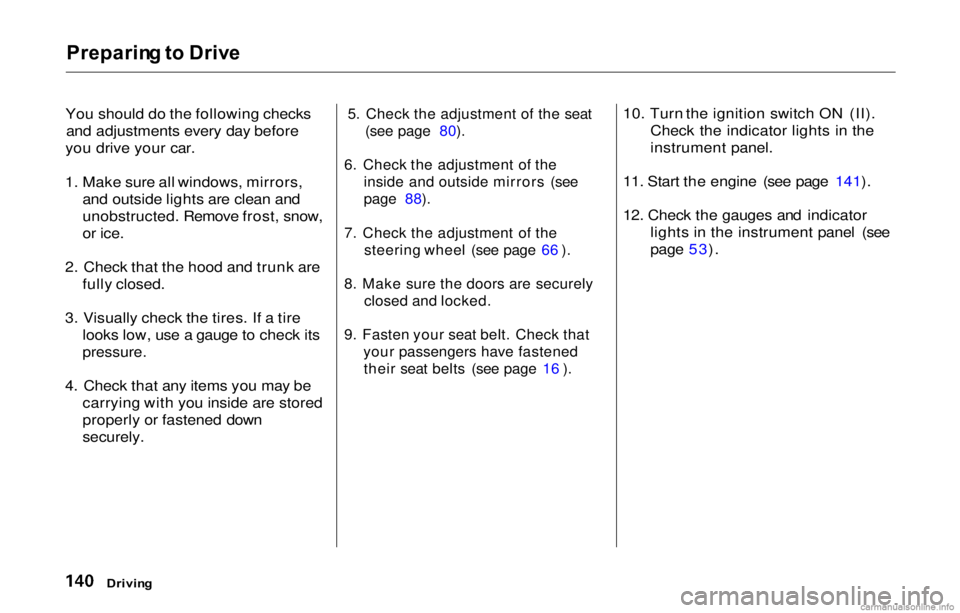
Preparing to Driv e
You should do the following checks
and adjustments every day before
you drive your car.
1. Make sure all windows, mirrors, and outside lights are clean and
unobstructed. Remove frost, snow,
or ice.
2. Check that the hood and trunk are fully closed.
3. Visually check the tires. If a tire looks low, use a gauge to check its
pressure.
4. Check that any items you may becarrying with you inside are stored
properly or fastened down
securely.
5. Check the adjustment of the seat (see page 80).
6. Check the adjustment of the inside and outside mirrors (see
page 88).
7. Check the adjustment of the steering wheel (see page 66 ).
8. Make sure the doors are securely closed and locked.
9. Fasten your seat belt. Check that your passengers have fastenedtheir seat belts (see page 16 ).10. Turn the ignition switch ON (II). Check the indicator lights in the
instrument panel.
11. Start the engine (see page 141).
12. Check the gauges and indicator lights in the instrument panel (see
page 53).
Drivin g
Page 144 of 293

Startin
g th e Engin e
1. Apply the parking brake.
2. In cold weather, turn off all electrical accessories to reduce
the drain on the battery.
3. Manual Transmission:
Push the clutch pedal down all the
way. START (III) does not function unless the clutch pedal is
depressed.
Automatic Transmission:
Make sure the shift lever is in
Park. Press on the brake pedal.
4. Without touching the accelerator pedal, turn the ignition key to theSTART (III) position. If the engine
does not start right away, do not
hold the key in START (III) for
more than 15 seconds at a time.
Pause for at least 10 seconds
before trying again. 5. If the engine does not start within
15 seconds, or starts but stalls
right away, repeat step 4 with the
accelerator pedal pressed half-way down. If the engine starts, release
pressure on the accelerator pedal so the engine does not race.
6. If the engine still does not start, press the accelerator pedal all the
way down and hold it there while starting in order to clear flooding.
As before, keep the ignition key in the START (III) position for nomore than 15 seconds. Return to step 5 if the engine does not start.
If it starts, lift your foot off the
accelerator pedal so the engine
does not race.
Startin g in Col d Weathe r a t Hig h
Altitude (Above 8,000 feet/
2,40 0 meters )
An engine is harder to start in cold weather. The thinner air found athigh altitude above 8,000 feet (2,400 meters) adds to the problem.
Use the following procedure:
1. Turn off all electrical accessories to reduce the drain on the battery.
2. Push the accelerator pedal half-
way to the floor and hold it there
while starting the engine. Do not hold the ignition key in START
(III) for more than 15 seconds. When the engine starts, release the accelerator pedal gradually as
the engine speeds up and smooths
out.
3. If the engine fails to start in step 2, push the accelerator pedal to the
floor and hold it there while you
try to start the engine for no more
than 15 seconds. If the engine does not start, return to step 2.
Driving
Page 145 of 293
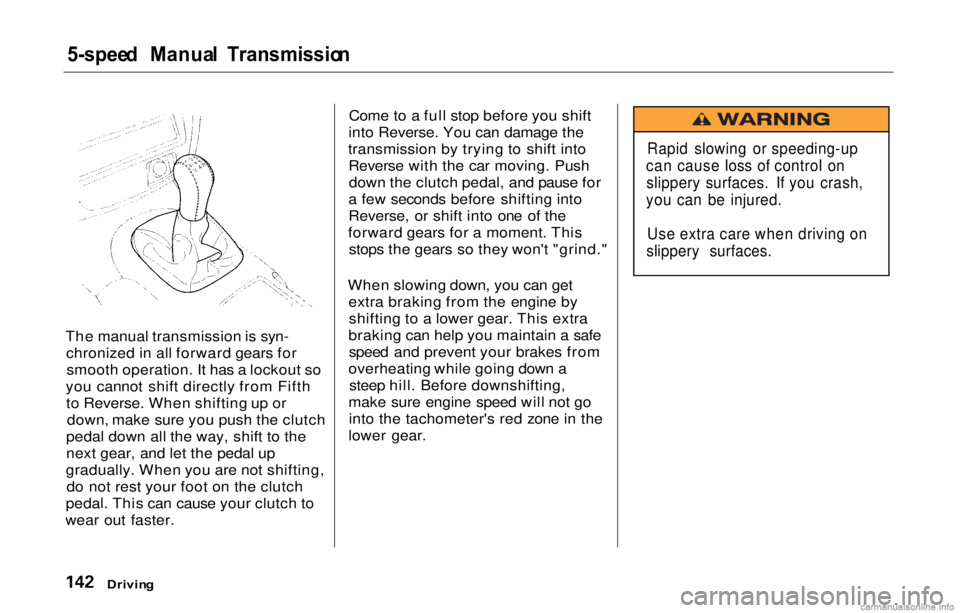
5-spee
d Manua l Transmissio n
The manual transmission is syn- chronized in all forward gears forsmooth operation. It has a lockout so
you cannot shift directly from Fifth to Reverse. When shifting up or down, make sure you push the clutch
pedal down all the way, shift to the
next gear, and let the pedal up
gradually. When you are not shifting, do not rest your foot on the clutch
pedal. This can cause your clutch to
wear out faster. Come to a full stop before you shift
into Reverse. You can damage the
transmission by trying to shift into Reverse with the car moving. Pushdown the clutch pedal, and pause for
a few seconds before shifting into
Reverse, or shift into one of the
forward gears for a moment. This stops the gears so they won't "grind."
When slowing down, you can get extra braking from the engine byshifting to a lower gear. This extra
braking can help you maintain a safe speed and prevent your brakes from
overheating while going down a steep hill. Before downshifting,
make sure engine speed will not go into the tachometer's red zone in the
lower gear.
Drivin g
Rapid slowing or speeding-up
can cause loss of control on slippery surfaces. If you crash,
you can be injured.
Use extra care when driving on
slippery surfaces.
Page 146 of 293
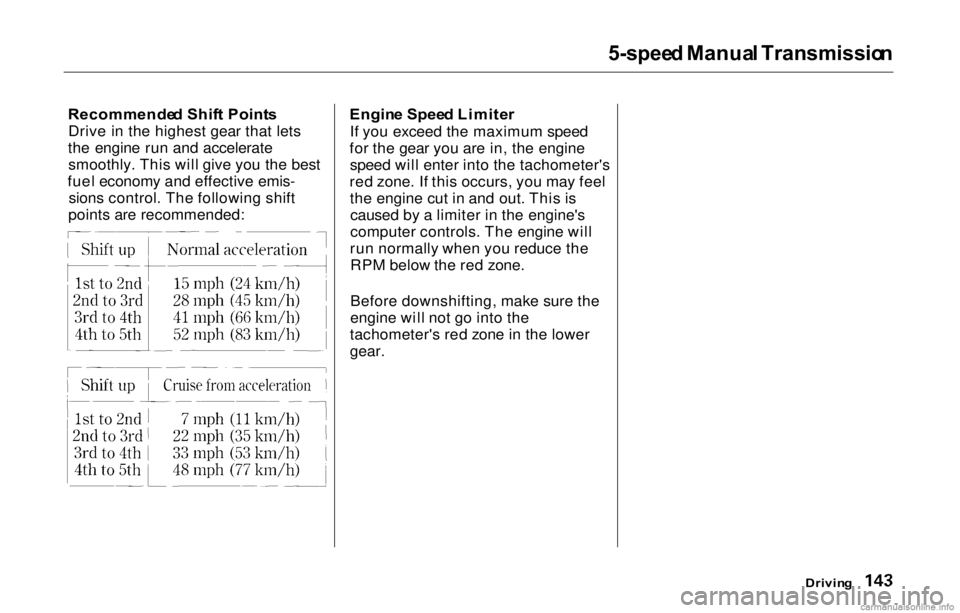
5-spee
d Manua l Transmissio n
Recommende d Shif t Point s
Drive in the highest gear that lets
the engine run and accelerate smoothly. This will give you the best
fuel economy and effective emis- sions control. The following shift
points are recommended: Engin
e Spee d Limite r
If you exceed the maximum speed
for the gear you are in, the engine speed will enter into the tachometer's
red zone. If this occurs, you may feel the engine cut in and out. This iscaused by a limiter in the engine's
computer controls. The engine will
run normally when you reduce the RPM below the red zone.
Before downshifting, make sure the
engine will not go into the
tachometer's red zone in the lower
gear.
Driving
Page 147 of 293
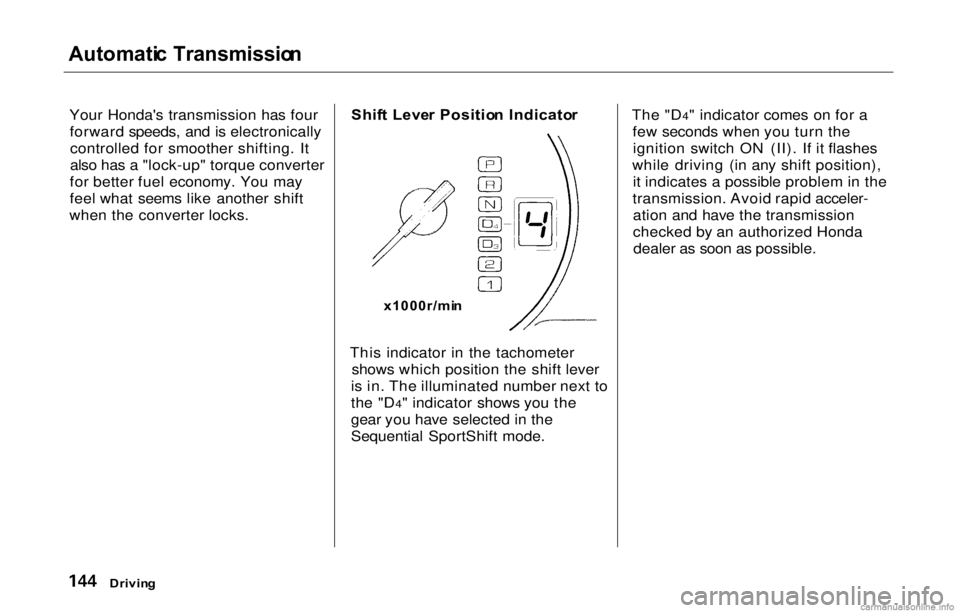
Automati
c Transmissio n
Your Honda's transmission has four forward speeds, and is electronicallycontrolled for smoother shifting. It
also has a "lock-up" torque converter
for better fuel economy. You may
feel what seems like another shift
when the converter locks. Shif
t Leve r Positio n Indicato r
x1000r/mi n
This indicator in the tachometer shows which position the shift lever
is in. The illuminated number next to
the "D4" indicator shows you the
gear you have selected in the
Sequential SportShift mode. The "D4" indicator comes on for a
few seconds when you turn theignition switch ON (II). If it flashes
while driving (in any shift position), it indicates a possible problem in the
transmission. Avoid rapid acceler- ation and have the transmission
checked by an authorized Hondadealer as soon as possible.
Drivin g
Page 148 of 293
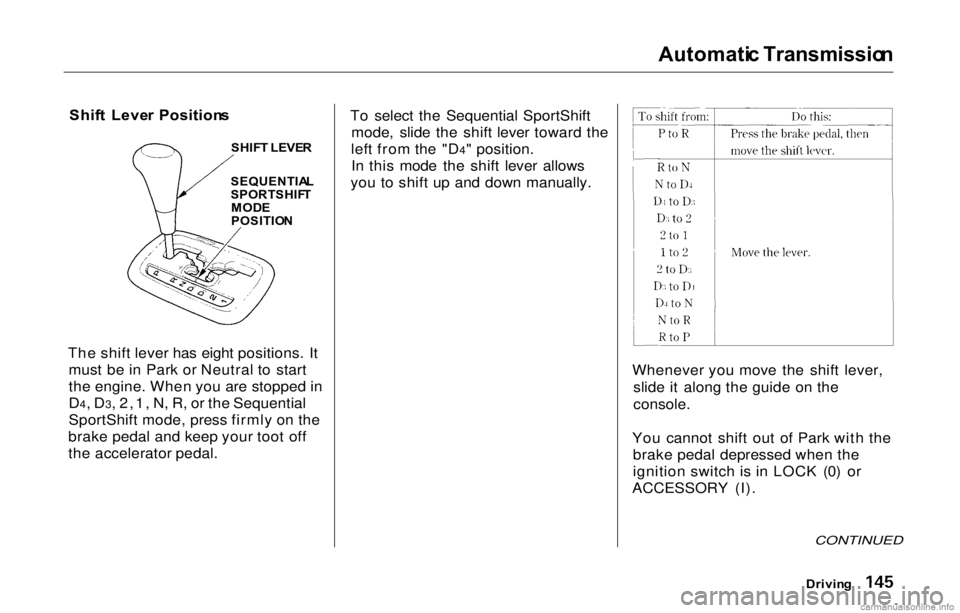
Automati
c Transmissio n
Shif t Leve r Position s
SHIF T LEVE R
The shift lever has eight positions. It must be in Park or Neutral to start
the engine. When you are stopped in
D4, D3, 2,1, N, R, or the Sequential
SportShift mode, press firmly on the
brake pedal and keep your toot off
the accelerator pedal. To select the Sequential SportShift
mode, slide the shift lever toward the
left from the "D4" position. In this mode the shift lever allows
you to shift up and down manually.
Whenever you move the shift lever,slide it along the guide on the
console.
You cannot shift out of Park with the brake pedal depressed when the
ignition switch is in LOCK (0) or
ACCESSORY (I).
CONTINUED
SEQUENTIA L
SPORTSHIF T
MOD E
POSITIO N
Driving
Page 149 of 293
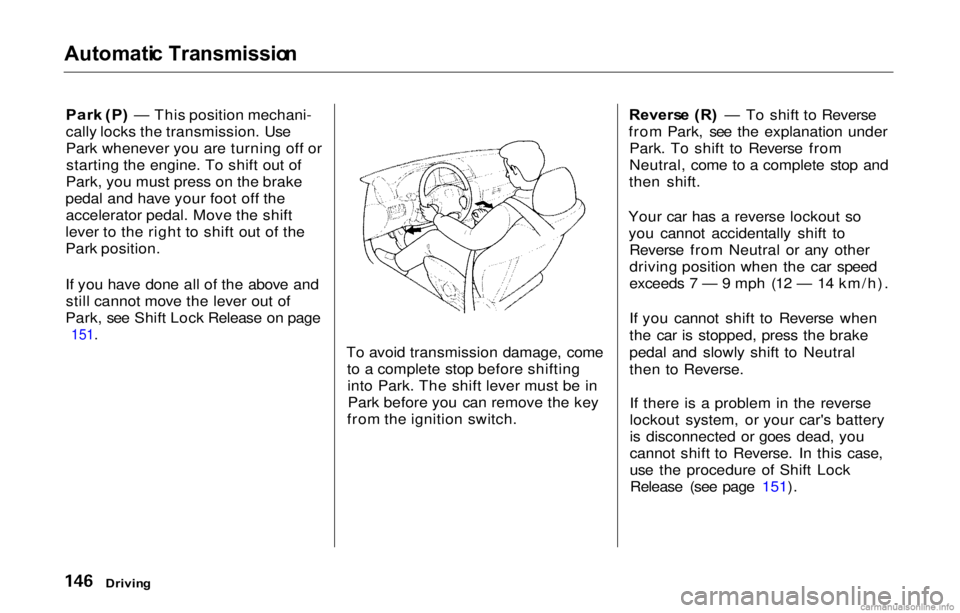
Automati
c Transmissio n
Par k (P ) — This position mechani-
cally locks the transmission. Use
Park whenever you are turning off or starting the engine. To shift out of
Park, you must press on the brake
pedal and have your foot off the accelerator pedal. Move the shift
lever to the right to shift out of the
Park position.
If you have done all of the above and still cannot move the lever out of
Park, see Shift Lock Release on page
151.
To avoid transmission damage, cometo a complete stop before shiftinginto Park. The shift lever must be inPark before you can remove the key
from the ignition switch. Revers
e (R ) — To shift to Reverse
from Park, see the explanation under Park. To shift to Reverse from
Neutral, come to a complete stop and
then shift.
Your car has a reverse lockout so you cannot accidentally shift to Reverse from Neutral or any other
driving position when the car speed
exceeds 7 — 9 mph (12 — 14 km/h).
If you cannot shift to Reverse when
the car is stopped, press the brake
pedal and slowly shift to Neutral
then to Reverse.
If there is a problem in the reverse
lockout system, or your car's battery
is disconnected or goes dead, you
cannot shift to Reverse. In this case,
use the procedure of Shift LockRelease (see page 151).
Drivin g
Page 150 of 293
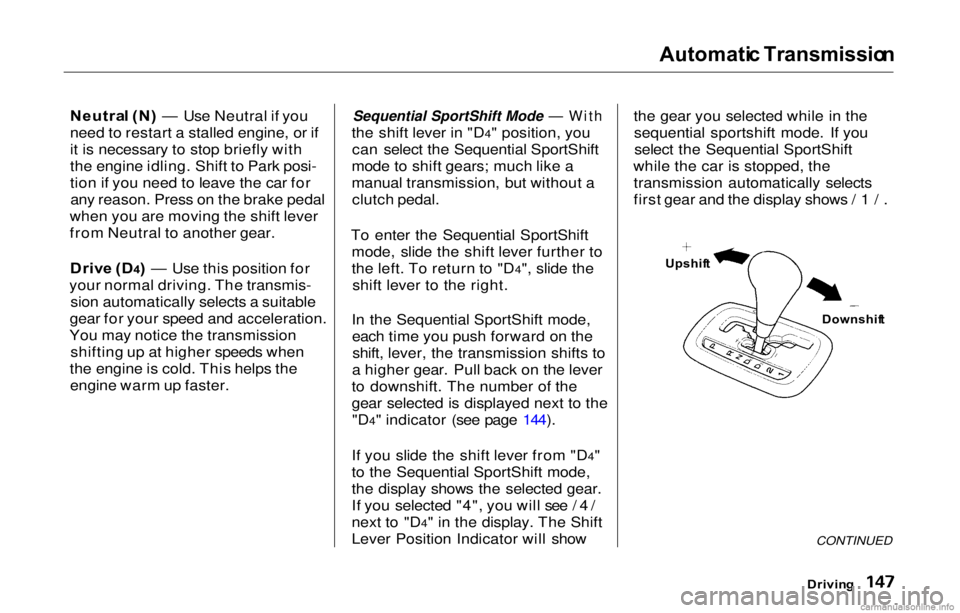
Automati
c Transmissio n
Neutra l (N ) — Use Neutral if you
need to restart a stalled engine, or if
it is necessary to stop briefly with
the engine idling. Shift to Park posi-
tion if you need to leave the car for any reason. Press on the brake pedal
when you are moving the shift lever
from Neutral to another gear.
Driv e (D 4) — Use this position for
your normal driving. The transmis- sion automatically selects a suitable
gear for your speed and acceleration.
You may notice the transmission shifting up at higher speeds when
the engine is cold. This helps the engine warm up faster.
Sequential SportShift Mode — With
the shift lever in "D4" position, you can select the Sequential SportShift
mode to shift gears; much like a
manual transmission, but without a clutch pedal.
To enter the Sequential SportShift mode, slide the shift lever further to
the left. To return to "D4", slide theshift lever to the right.
In the Sequential SportShift mode, each time you push forward on theshift, lever, the transmission shifts to
a higher gear. Pull back on the lever
to downshift. The number of the
gear selected is displayed next to the "D4" indicator (see page 144).
If you slide the shift lever from "D4"
to the Sequential SportShift mode,
the display shows the selected gear.
If you selected "4", you will see /4/
next to "D4" in the display. The Shift
Lever Position Indicator will show the gear you selected while in the
sequential sportshift mode. If youselect the Sequential SportShift
while the car is stopped, the transmission automatically selects
first gear and the display shows /1/.
CONTINUED
Upshif
t
Downshift
Drivin g